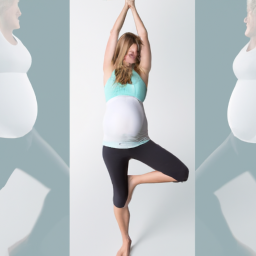Are you an expecting mother looking to stay fit and healthy throughout your pregnancy? Look no further! Introducing “Pregnancy Workout Routines: Safe and Effective Exercises for Expecting Mothers,” a comprehensive guide designed specifically for soon-to-be moms like you. This invaluable resource provides a wide range of workout routines carefully curated to cater to the needs of pregnant women. Whether you’re a fitness enthusiast or just starting your fitness journey, these exercises are guaranteed to keep you active and feeling great during this special time in your life. Say goodbye to uncertainties and hello to a stronger, healthier you with these safe and effective pregnancy workout routines.
Benefits of Exercise During Pregnancy
Exercise during pregnancy offers numerous benefits for both the mother and the baby. It can help improve overall health, maintain a healthy weight, reduce pregnancy discomforts, boost mood, increase energy levels, and promote better sleep. Staying active during pregnancy can also contribute to a smoother labor and delivery, as well as a faster recovery postpartum. However, it is important to consult with a healthcare provider before starting any exercise routine during pregnancy.
Consultation with a Healthcare Provider
Before embarking on any workout routine during pregnancy, it is crucial to consult with a healthcare provider. They can provide personalized advice based on your individual health and pregnancy history. Your healthcare provider will be able to assess whether it is safe for you to exercise and recommend any necessary modifications or limitations.
Importance of Medical Clearance
Obtaining medical clearance from your healthcare provider is essential to ensure that there are no underlying health concerns or complications that could be exacerbated by exercise. Certain conditions, such as pregnancy-induced hypertension or placenta previa, may require special considerations or restrictions when it comes to exercise. It is crucial to follow your healthcare provider’s recommendations and guidance to ensure the safety of both you and your baby.
Choosing a Suitable Workout Routine
Once you have obtained medical clearance, it is important to choose a workout routine that is suitable for pregnancy. Not all exercises are safe or appropriate during this stage, so it is essential to select activities that are specifically designed for expecting mothers. Pregnancy-specific workout routines focus on strengthening the muscles needed for labor and delivery, improving posture, and promoting overall prenatal fitness.
Types of Pregnancy Workout Routines
There are several types of pregnancy workout routines that can be beneficial for expectant mothers. These include cardiovascular exercises, strength training, prenatal yoga, and pilates. Each type of workout offers unique benefits and considerations.
Cardiovascular Exercises
Cardiovascular exercises, also known as aerobic exercises, are activities that increase your heart rate and improve cardiovascular fitness. These exercises help to strengthen the heart and lungs, improve circulation, and increase endurance. For pregnant women, cardiovascular exercises can also enhance overall stamina and support healthy weight management.
Strength Training
Strength training, or resistance training, involves using weights, resistance bands, or bodyweight exercises to build and tone muscles. During pregnancy, strength training exercises can help improve core strength, promote better posture, and support the muscles required for carrying the additional weight of the baby. It is important to choose exercises that focus on the major muscle groups and avoid heavy weights or exercises that strain the pelvic floor.
Prenatal Yoga
Prenatal yoga is a gentle form of exercise that combines breathing techniques, stretching, and relaxation. It can help improve flexibility, balance, and circulation while reducing stress and anxiety. Prenatal yoga also focuses on strengthening the pelvic floor, which is essential for a healthy pregnancy and easier labor. It is important to choose yoga poses that are safe for pregnancy and avoid deep twists or poses that place pressure on the abdomen.
Pilates
Pilates is a low-impact exercise system that focuses on core strength, flexibility, and balance. It can help improve posture, strengthen the back and abdominal muscles, and promote overall body awareness. During pregnancy, pilates exercises can be modified to accommodate the changes in the body. It is important to choose exercises that avoid lying flat on the back and focus on engaging the deep core muscles.
Cardiovascular Exercises
Engaging in cardiovascular exercises during pregnancy offers a wide range of benefits for both the mother and the baby.
Benefits of Cardiovascular Exercises During Pregnancy
Cardiovascular exercises improve heart and lung function, boost energy levels, and promote a healthy weight gain during pregnancy. Regular aerobic activity can also reduce the risk of gestational diabetes, preeclampsia, and excessive weight gain. Additionally, cardiovascular exercises increase endorphin levels, which can help alleviate pregnancy-related mood swings and improve overall mental well-being.
Recommended Cardiovascular Workouts
Low-impact exercises such as walking, swimming, stationary cycling, and prenatal aerobics classes are generally safe and beneficial for pregnant women. These activities provide a moderate intensity workout without placing excessive stress on the joints. It is important to listen to your body and avoid overexertion. If you were already participating in higher-impact activities prior to pregnancy, consult with your healthcare provider for modifications or alternatives.
Safety Considerations
When engaging in cardiovascular exercises during pregnancy, it is important to pay attention to safety considerations. It is recommended to wear supportive footwear and comfortable clothing that allows for freedom of movement. Stay hydrated by drinking water before, during, and after exercise. Take breaks and rest when needed, and always listen to your body’s cues. Avoid exercising in hot and humid conditions, and be mindful of any warning signs such as dizziness, shortness of breath, or vaginal bleeding. If you experience any discomfort or have concerns, consult with your healthcare provider.
Strength Training
Incorporating strength training into your pregnancy workout routine can provide a range of benefits for both you and your baby.
Benefits of Strength Training During Pregnancy
Strength training exercises help strengthen and tone the muscles, improve posture, and support the additional weight of the baby. Building strength in the pelvic floor and deep core muscles can aid in better balance, reduce back pain, and enhance overall stability. Strength training also boosts metabolism, which can help maintain a healthy weight gain during pregnancy and assist with postpartum weight loss.
Recommended Strength Training Exercises
During pregnancy, it is important to choose strength training exercises that target the major muscle groups, such as the arms, legs, back, and core. Bodyweight exercises, resistance bands, and light dumbbells are safe and effective tools for strength training during this time. Avoid exercises that put excessive pressure on the abdomen or require lying flat on the back, especially after the first trimester. It is recommended to work with a qualified prenatal fitness professional or seek guidance from a healthcare provider to ensure proper form and technique.
Safety Considerations
Safety is paramount when incorporating strength training into your pregnancy workout routine. Start with lighter weights or resistance and gradually increase as your strength improves. Focus on maintaining proper form and technique throughout each exercise. Be mindful of your breathing, and avoid holding your breath or straining excessively. It is important to listen to your body and stop exercising if you experience any pain, discomfort, or unusual symptoms. Always consult with a healthcare provider before initiating any new exercise program during pregnancy.
Prenatal Yoga
Prenatal yoga offers numerous benefits for expectant mothers, both physically and emotionally.
Benefits of Prenatal Yoga
Prenatal yoga helps improve flexibility, balance, and circulation, while promoting relaxation and stress relief. The gentle stretching and breathing techniques can aid in reducing pregnancy discomforts, such as back pain and swelling. Prenatal yoga also focuses on strengthening the pelvic floor and deep core muscles, which can enhance overall body awareness and prepare the body for labor and delivery.
Recommended Prenatal Yoga Poses
When practicing prenatal yoga, it is important to choose poses that are safe and suitable for pregnancy. Gentle, modified versions of traditional yoga poses are generally recommended. Poses that avoid deep twists, excessive abdominal stretching, or lying flat on the back are ideal. Focus on poses that promote proper alignment, and use props such as blocks or bolsters for support if needed. It is advised to practice prenatal yoga under the guidance of a qualified prenatal yoga instructor to ensure safety and proper technique.
Precautions and Safety Guidelines
While prenatal yoga is considered safe for most pregnant women, it is important to take precautions and follow safety guidelines. Avoid overstretching or pushing beyond your comfort zone. Listen to your body and modify poses as needed. Use props for support and stability. Stay hydrated and avoid practicing in excessively hot or humid conditions. If you have any concerns or medical conditions, consult with your healthcare provider before starting prenatal yoga.
Pilates
Pilates is a low-impact exercise system that can be highly beneficial for pregnant women.
Benefits of Pilates During Pregnancy
Pilates focuses on strengthening the core, improving posture, and enhancing overall body awareness. The controlled movements and emphasis on breath can help reduce back pain, increase flexibility, and improve stability. Pilates exercises also promote better pelvic floor function, which is crucial for a healthy pregnancy and easier labor. By practicing pilates during pregnancy, you can enhance your strength and prepare your body for the physical demands of motherhood.
Recommended Pilates Exercises
During pregnancy, it is important to modify pilates exercises to accommodate the changes in your body. Focus on exercises that avoid lying flat on the back, especially after the first trimester, as this position can put pressure on the blood vessels and reduce blood flow to the uterus. Opt for exercises that engage the deep core muscles, promote proper alignment, and avoid excessive strain on the abdominal muscles. It is recommended to work with a qualified prenatal pilates instructor or seek guidance from a healthcare provider to ensure safety and appropriate modifications.
Safety Considerations
When practicing pilates during pregnancy, safety should always be a top priority. Start with gentle exercises and progress gradually as your strength and stamina improve. Avoid movements that cause discomfort or pain. Listen to your body and take breaks when needed. Use props such as pillows or cushions for support, especially when lying on your side. It is important to work with a qualified instructor who is knowledgeable about prenatal pilates and can provide proper guidance and modifications.
Exercises to Avoid During Pregnancy
While exercise is generally beneficial during pregnancy, there are certain activities that should be avoided due to potential risks.
High-Impact Activities
High-impact activities, such as running or jumping, can place excessive stress on the joints and pelvic floor. These activities may increase the risk of falls or injuries. It is best to choose low-impact exercises that provide cardiovascular benefits without putting excessive strain on the body.
Activities with a Risk of Falling
Engaging in activities with a high risk of falling, such as skiing, horseback riding, or contact sports, should be avoided during pregnancy. The risk of impact or injury to the abdomen is increased, which can be potentially harmful to both the mother and the baby. It is important to choose activities that are safe and minimize the risk of falls or accidents.
Exercises Lying on the Back
After the first trimester, it is advised to avoid exercises that require lying flat on the back for an extended period of time. This position can put pressure on major blood vessels, reducing blood flow to the uterus and potentially causing dizziness or shortness of breath. Opt for exercises in a side-lying position or modify exercises to ensure proper blood flow to the baby.
Activities with a Risk of Abdominal Trauma
Exercises or activities that pose a risk of abdominal trauma, such as kickboxing or high-impact sports, should be avoided during pregnancy. Impact or contact to the abdomen can potentially harm the baby or cause complications. It is important to prioritize the safety and well-being of the baby by choosing activities that minimize the risk of abdominal trauma.
Exercises Requiring Breath Holding
Exercises that require breath holding, such as certain weightlifting techniques or deep-sea diving, should be avoided during pregnancy. Holding your breath can restrict oxygen flow to the baby and may increase the risk of dizziness or fainting. Choose exercises that allow for normal breathing patterns and avoid any activities that require breath holding or prolonged times without oxygen.
Tips for a Safe Pregnancy Workout
When engaging in a pregnancy workout routine, it is important to keep the following tips in mind to ensure safety and maximize the benefits.
Start Slow and Progress Gradually
If you were not regularly exercising before pregnancy, it is important to start slowly and gradually increase the intensity and duration of your workouts. Listen to your body and give yourself time to adjust. Gradually build up your stamina and strength over time. Remember, pregnancy is not the time to set personal fitness records but rather to maintain a safe and healthy level of physical activity.
Stay Hydrated
Staying hydrated is crucial during pregnancy, especially when engaging in exercise. Drink plenty of water before, during, and after your workouts to prevent dehydration. Dehydration can lead to overheating, dizziness, and other complications. Be sure to have a water bottle with you and take regular sips throughout your exercise session.
Warm-Up and Cool-Down
Before starting any workout, it is important to warm up your muscles and prepare your body for exercise. Spend a few minutes engaging in light cardiovascular activity, such as brisk walking or gentle stretching. After your workout, take time to cool down and gradually bring your heart rate back to its resting state. This can be done by slowing down the intensity of your exercise and completing gentle stretching exercises.
Listen to Your Body
One of the most important aspects of exercising during pregnancy is listening to your body. Pay attention to any warning signs or discomforts and adjust your exercises accordingly. If something doesn’t feel right or causes pain, stop immediately. It is normal to feel more fatigued and slower during pregnancy, so be sure to rest when needed and take breaks as necessary.
Use Proper Form and Technique
Using proper form and technique is crucial during pregnancy to prevent injuries and maintain optimal muscle activation. Focus on your posture and alignment during each exercise. Engage the appropriate muscles and avoid straining or compensating with other muscle groups. If you are unsure about the correct form, seek guidance from a qualified instructor or healthcare provider.
Avoid Overexertion
While exercise is important during pregnancy, it is essential to avoid overexertion. Pushing your body to the point of exhaustion or breathlessness can be harmful. Aim for a moderate level of intensity where you are still able to carry on a conversation without difficulty. Remember that pregnancy is a time for gentle and safe exercise, not for pushing yourself to the limits.
Additional Considerations
There are a few additional considerations to keep in mind when exercising during pregnancy.
Exercise Clothing and Gear
Wear comfortable and breathable exercise clothing that allows for freedom of movement. Invest in a supportive and well-fitted sports bra to provide adequate breast support. Choose appropriate footwear that offers stability and cushioning. It is important to prioritize comfort and safety when it comes to exercise clothing and gear.
Safety Measures at a Gym
If exercising at a gym, be sure to familiarize yourself with the safety measures in place. Check that the equipment is clean and well-maintained. Use proper weightlifting techniques and avoid heavy weights or exercises that strain the pelvic floor. If you are uncertain about using certain equipment or have concerns about the gym environment, consult with a fitness professional or consider alternative workout options.
Tracking Your Heart Rate
While it is no longer recommended to strictly monitor heart rate during exercise, it can still be helpful to gauge your exertion levels. Use the “talk test” as a simple way to determine if you are exercising at an appropriate intensity. If you can carry on a conversation without difficulty, you are likely exercising at a safe and moderate level. If you are experiencing shortness of breath or are unable to speak comfortably, it is a sign that you may be overexerting yourself.
In conclusion, exercise during pregnancy can offer a multitude of benefits for both the mother and the baby. By consulting with a healthcare provider, choosing a suitable workout routine, and following safety guidelines, expectant mothers can engage in safe and effective exercise throughout their pregnancy. From cardiovascular exercises to strength training, prenatal yoga, and pilates, there are various options to support a healthy and active lifestyle during this special time. Remember to listen to your body, stay hydrated, and prioritize safety to ensure a safe and enjoyable pregnancy workout experience.





